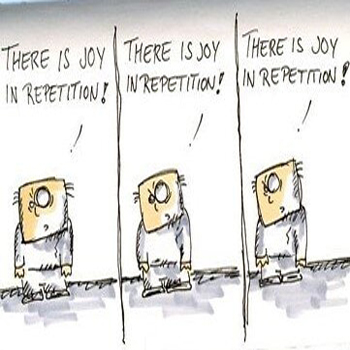Blog
How Many Times Do I Have To Tell You
Author: Kathleen Nelson-Simley
Posted: Thursday - January 28, 2021
“If I’ve told you once, I’ve told you a thousand times.”
Have you ever had this said to you or even said it to someone yourself? This statement is usually said in annoyance and frustration after saying something repeatedly to someone.
But did you know there are times when having to repeat yourself is a necessary and even effective communication strategy with students?
Anyone with kids understands the power of redundant communication. How many children will clean their room the first time a parent tells them to do it? Or even the second time?
If you want a specific message to stick in the brains of kids they need to hear the same consistent message over and over and over from you. Repetition in communication is a tool you should use intentionally with your students.
The idea of communicating a message over and over again isn’t new and its roots are in advertising and marketing. “Effective frequency” is a term used to define the number of times a person needs to hear an advertising message before responding to it. Different experts have different ideas for what that magic number is. The most agreed-upon is probably the “Rule of 7,” which suggests consumers need to hear a message seven times before they will consider taking action.
Applying the “Rule of 7” to the messages you want to have sink in with your students is something to carefully consider, especially if you want them to take certain actions.
The first thing you need to do is determine what the most important messages are you want to have sink in with your students. It’s better to have fewer messages communicated as long as the messages are the most effective at getting the desired behavior you want from your students.
For example, if your goal is to keep your students from engaging in risky behaviors, it is important you are communicating proven, research-based messages. Communicating just any prevention message over and over will likely not reap the results you are hoping for.
The next thing you need to determine is who the most influential messengers of each message will be. The more adults a student hears the same message from validates the message and increases the likelihood the student will believe it and act on it.
Stop and think about how many different adults in one day an adolescent is in contact with who can communicate an important message. A parent, bus driver, carpool driver, custodian, classroom teacher, school administrator, coach, afterschool staff, friend’s parent, adult sibling…the list goes on and on.
Once you determine who the most influential messengers are make sure they are all communicating the same message consistently. An inconsistent message repeated over and over can sometimes do more harm than good.
Now, let’s go back to your goal of keeping your students from engaging in risky behaviors…If your prevention message is delivered by one teacher in your school or organization through a specific prevention curriculum or program and the teacher or the program doesn’t reinforce the same message at least seven times over, then you are not likely getting the best return for your investment. Rather, having more people delivering and reinforcing the same prevention message in multiple ways, in addition to the teacher and the prevention program, increases the likelihood of meeting the “Rule of 7” and getting the behaviors you want from your students.
If you are worrying your students are going to tune you out if they hear the same message repeated too much, don’t worry. They aren’t paying nearly as much attention to your communication as you wish they were. You are likely to get tired of hearing yourself repeat the same message over and over before they do.
So, the next time you find yourself thinking or saying, “If I’ve told you once, I’ve told you a thousand times,” to your students, don't be annoyed or frustrated. Just smile and pat yourself on the back. You are doing what you need to be doing.



